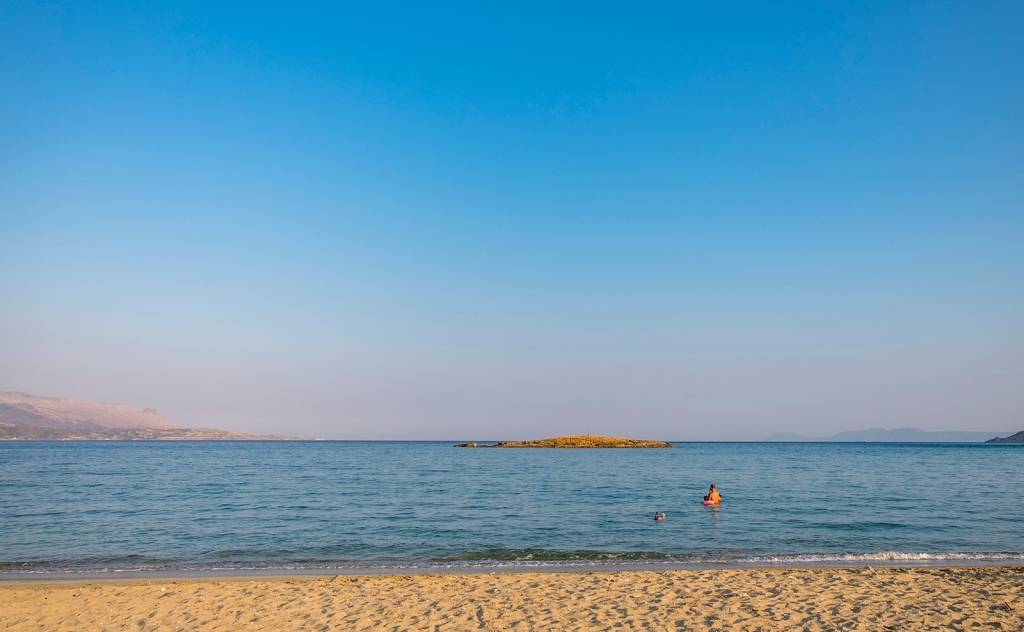Pavlopetri

Just seven hundred metres northeast of Elafonissos, there is an islet called Pavlopetri. There, one can find the remains of a submerged settlement - the world's oldest submerged state, spanning about 50 acres.
This underwater settlement is accessible to visitors, as the waters are clear and their depth does not exceed 3 metres. The settlement includes intact top views of buildings, roads, box-shaped and chamber tombs. Based on the pottery fragments found, archaeologists conclude that this is a prehistoric settlement, first inhabited in the Final Neolithic Period (4500-3200 BC) and extends over all three Bronze Age periods. A rare phenomenon that Pavlopetri presents is the continuous habitation of the site from 3000-1100 BC. Findings from the Prehistoric settlement are on display at the Archaeological Museum of Neapolis. Pavlopetri is located at the crossroads of Elafonissos-Kythira-Antikythera-Crete, so a commercial connection with these places is very likely. Jar fragments and textile weights confirm a kind of "craft" of the time. The excavated ceramic pieces have influences from Minoan, Kythiraic, Cycladic and Laconian patterns.
In 1904, geologist Fokion Negris (first president of the Academy of Athens) was the one who observed the architectural remains of the settlement. His observations were confirmed several years later by the visit of oceanographer Nicholas Flemming in 1967. In 1968, a mission by the University of Cambridge's submarine exploration team was organised, where a detailed listing of the visible remains was made with the help of a kind of lattice consisting of intersecting lines. A Greek archaeological team led by archaeologist Angelos Delivorias also participated in the research. This research did not excavate the site except for the superficial collection of findings.
No two are the same of the buildings found, with a single common feature, a large central room (usually rectangular), with a courtyard. There is only one with distinctive style among the buildings: there are small arches at the north and south ends, while the east side of the building, in fact, consists of only ten stones. Three Early-Hellenic conical bowls were found between the walls, an indication that the building may have been used for funerary rituals. The streets of Pavlopetri are about 5 metres wide. Characteristic is that they are made of straight lines of houses, a building element of modern Elafonissos.
An integral feature of the underwater settlement is the forty box-shaped tombs, found between or inside buildings, beneath the floor of houses, even within walls. They consist of four upright limestone slabs forming a rectangle, while a fifth slab covers the burial. They are all small in size, referring to the burial of children. That is why they were found inside the buildings. People were holding the children who had died near them in some housing area. Perhaps they did so to encourage fertility in the household or ensure that other children would come later.
The archaeological team also mapped the cemetery on the coast of Punta, which contains sixty graves carved into the rocks. Unfortunately, some tombs have been partially or entirely destroyed during the canal's construction (leading to Lake Stroggili) and subsequent quarrying activities. Also, many of them are below the surface of the water today. There are visible traces of slate quarrying on the coast, which is abundant throughout the area. The existence of a quarry probably dates back to the Roman era.
After the 1968 survey, Pavlopetri was declared an archaeological site. In 2009, the Ephorate of Underwater Antiquities, in collaboration with the University of Nottingham, and the British School of Athens, launched a five-year programme to study the history of the swamped city. Using advanced technology, archaeologists have identified the known extent of the remains while, at the same time, they discovered and mapped over 9,000 square metres of new building complexes. There were four new box-shaped tombs and an uncovered burial in a big jar shaped grave among the findings. Also of great importance was the excavation of some pottery shells dating back to the First - geometric, Classical, Hellenistic, Roman and Byzantine periods.
In 2011, an excavation of the settlement was carried out for the first time. Specifically, two incisions were made at points where the outlines of buried big jars were visible. From the first section, two jars were excavated, which are today at the Pylos Archaeological Museum in Niokastro.
From the radioactive carbon dating process of successive lines of coastal rocks, it appears that there was more than one seismic event that plunged the ancient city. It is quite possible that Pavlopetri sank in at least three consecutive earthquakes, with the first occurring shortly after 1000 BC. Based on the age of the artefacts that exist throughout the area, one can get the impression that Pavlopetri reached its peak around 1600 BC. It was a city with an organised layout. People lived next to each other, in neighbourhoods. They had large houses with courtyards and rooms on different floors. Pavlopetri started from a small fishing village and developed into a busy port with connections across the Aegean Sea and then to Crete and the Eastern Mediterranean. Pavlopetri is the first underwater city to be digitally recreated in three dimensions. The work of the archaeological team was put together in a documentary aired by BBC 2 in 2011 entitled "The City Under the Waves: Pavlopetri".



